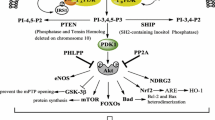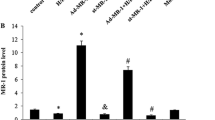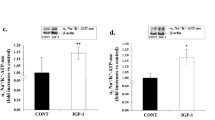Abstract
To determine whether Insulin-like growth factor (IGF-I) treatment represents a potential means of enhancing the survival of cardiac muscle cells from adriamycin (ADR)-induced cell death, the present study examined the ability of IGF-I to prevent cell death. The study was performed utilising the embryonic, rat, cardiac muscle cell line, H9C2. Incubating cardiac muscle cells in the presence of adriamycin increased cell death, as determined by MTT assay and annexin V-positive cell number. The addition of 100 ng/mL IGF-I, in the presence of adriamycin, decreased apoptosis. The effect of IGF-I on phosphorylation of PI, a substrate of phosphatidylinositol 3-kinase (PI 3-kinase) or protein kinase B (AKT), was also examined in H9C2 cardiac muscle cells. IGF-I increased the phosphorylation of ERK 1 and 2 and PKC ζ kinase. The use of inhibitors of PI 3-kinase (LY 294002), in the cell death assay, demonstrated partial abrogation of the protective effect of IGF-I. The MEK1 inhibitor-PD098059 and the PKC inhibitor-chelerythrine exhibited no effect on IGF-1-induced cell protection. In the regulatory subunit of PI3K-p85- dominant, negative plasmid-transfected cells, the IGF-1-induced protective effect was reversed. This data demonstrates that IGF-I protects cardiac muscle cells from ADR-induced cell death. Although IGF-I activates several signaling pathways that contribute to its protective effect in other cell types, only activation of PI 3-kinase contributes to this effect in H9C2 cardiac muscle cells.
Similar content being viewed by others
References
Andoh, T., Lee, S. Y., and Chineh, C. C., Preconditioning regulation of bcl-2 and p66shc by human NOS1 enhances tolerance to oxidative stress.FASEB J., 14, 2144–2146 (2000).
Andrieu-Abadie, N., Jaffrezou, J. P., Hatem, S., Laurent, G., Levade, T., and Mercadier, J. J., L-Camitine prevents doxorubicin-induced apoptosis of cardiac myocytes: role of inhibition of ceramide generation.FASEB J., 13, 1501–1510 (1999).
Li, A. E., Ito, H., Rovira, I. I., Kim, K. S., Takeda, K., Yu, Z. Y., Ferrans, V. J., and Finkel, T., A role for reactive oxygen species in endothelial cell anoikis.Circ. Res., 85, 304–310 (1999).
Cain, K., Brown, D. G., Langlis, C., and Cohen, G. M., Caspase activation involves the formation of the apotosome, a large (approximately 700 kDa) caspase-activating complex.J. Biol. Chem., 274, 22686–22692 (1999).
Chae, H. J., Chae, S. W., Kang, J. S., Bang, B. G., Cho, S. B., Park, R. K., So, H. S., Kim, Y. K., Kim, H. M., and Kim, H. R., Dexamethasone suppresses tumor necrosis factor-alpha-induced apoptosis in osteoblast: possible role for ceramide.Endocrinology, 141, 2904–2913 (2000).
Chae, H. J., Chae, S. W., Kang, J. S., Bang, B. G., Han, J. I., Moon, S. R., Park, R., So, H. S., Jee, K. S., Kim, H. M., and Kim, H. R., Effect of ionizing radiation on the differentiation of ROS 17/2.8 osteoblasts through free radicals.J. Radial Res., 40, 323–335 (1999).
Chesley, A., Lundberg, M. S., Asai, T., Xiao, R. P., Ohtani, S., Lakatta, E. G., and Crow, M. T., The β2-adrenergic receptor delivers an antiapoptotic signal to cardiac myocytes through Gi-dependent coupling to phosphatidylinositol 3′-kinase.Circ. Res., 87, 1172–1179 (2000).
Crompton, M., The mitochondrial permeability transition pore and its role in cell death.Biochem. J., 341, 233–249 (1999).
Doroshow, J. H., Doxorubicin-induced cardiac toxicity.N. Engl. J. Med., 324, 843–845 (1991).
Ettinghausen, S. E., Bonow, R. O., Palmeri, S. T., Seipp, C. A., Steinberg, S. M., White, D. E., and Rosenberg, S. A., Prospective study of cardiomyopathy induced by adjuvant doxorubicin therapy in patients with soft-tissue sarcomas.Arch. Surg., 121, 1445–1451 (1986).
Gross, A., Yin, X. M., Wang, K., Wei, M. C., Jockel, J., Milliman, C., Erdjment-Bromege, H., Tempst, P., and Korsmeyer, S. J., Caspase cleaved BID targets mitochondria and is required for cytochrome d release while Bcl-XL prevents this release but not tumor necrosis factor-R1/Fas death.J. Biol. Chem., 274, 1156–1163 (1999).
Hitchcock-Bryan, S., Gelber, R. D., Cassady, J. R., and Sallan, S. E., The impact of induction anthracycline on long-term failure-free survival in child-free survival in childhood acute lymphoblastic leukemia.Med. Pedioatr. Oncol., 14, 211–215 (1986).
Kang, Y. J., Chen, Y., and Epstein, P. N., Suppression of doxorubicin cardiotoxicity by overexpression of catalase in the heart of transgenic mice.J. Biol. Chem., 271, 12610–12616 (1996).
Kluck, R. M., Bossy-Wetzel, E., Green, D. R., and Newmeyer, D. D., The release of cytochrome c from mitochondria: a primary site for Bcl-2 regulation of apoptosis.Science, 275, 1132–1136 (1996).
Li, T. and Singal, P. K., Adriamycin-induced early changes in myocardial antioxidant enzymes and the modulation by probucol.Circulation, 102, 2105–2110 (2000).
Linassier, C., MacDougall, L. K., Domin, J., and Waterfield, M. D., Molecular cloning and biochemical characterization of a Drosophila phosphatidylinositol-specific phosphoinositide 3- kinase.Biochem. J., 321, 849–856 (1997).
Maulik, N., Engelman, R. M., Rousou, J.A., Flack, J. E., Deaton, D., and Das, D. K., Ischemic preconditioning reduces apoptosis by upregulating anti-death gene Bcl-2.Circulation, 100 (19 Suppl), 369–375 (1999).
Nowak, D., Pierscinski, G., and Drzewoski, J., Ambroxol inhibits doxorubicin-induced lipid peroxidation in mice.Free Radic. Biol. Med., 19, 659–663 (1995).
Okamoto, M., Hayashi, T., Kono, S., Inoue, G., Kubota, M., Okamoto, M., Kuzuya, H., and Imura, H., Specific activity of phosphatidylinositol 3-kinase is increased by insulin stimulation.Biochem. J., 290, 327–333 (1993).
Perry, D. K., Smyth, M. J., Steinicke, H. R., Salvesen, G. S., Duriez, P., Poirier, G. G., and Hannun, Y. A., Zinc is a potent inhibitor of the apoptotic protease, caspase-3. A novel target for zinc in the inhibition of apoptosis.J. Biol. Chem., 272, 18530–18533 (1997).
Richard, L., Sundararajah, T., Marsela, D. R., Maryely, D. L., and Prasad, D., Partial ATP depletion induces Fas-and caspase-mediated apoptosis in MDCK cells.Am. J. Physiol., 276, F837–846 (1999).
Sasaki, H., Akamatsu, H., and Horio, T., Effects of a single exposure to UVB radiation on the activities and protein level of copper-zinc and manganese superoxide dismutase in cultured human keratinocytes.Photochem. Photobiol., 65, 707–713 (1997).
Schlumberger, M., Parmentier, C., Delisle, M. J., Couette, J. E., Droz, J. P., and Sarrazin, D., Combination therapy for nanplastic giant cell thyroid carcinoma.Cancer, 67, 564–566 (1991).
Sonoda, Y., Yang, Y. C., Wong, G. G., Clark, S. C., and Ogawa, M., Erythroid burst-promoting activity of purified recombinant human GM-CSF and interleukin-3 studies with anti-GM-CSF and anti-IL-3 sera and studies in serum-free cultures.Blood, 72, 1381–1386 (1988).
Takahashi, H., Nakamura, S., Asano, K., Kinouchi, M., Ishida-Yamamoto A., and lizuka, H., Fas antigen modulates ultraviolet B-induced apoptosis of SVHK cells: sequential activation of caspase 8, 3, and 1 in the apoptotic process.Exp. Cell Res., 249, 291–298 (1999).
Tatsuta, T., Shiraishi, A., and Mountz, J. D., The prodomain of caspase-1 enhances Fas-mediated apoptosis through facilitation of caspase-8 activation.J. Biol. Chem., 275, 14248–14254 (2000).
Vanio, M., Rozen, L., Bernard, C., Ljubka, M., and Louis-Marie, H., Epidermal growth factor stimulates mitogen-activated protein kinase by a PKC-dependent pathway in human keratinocytes. Biochem. Biophys.Res. Comun., 208, 245–252 (1995).
Wang, L., Ma, W., Markovich, R., Chen, J-W., and Wang, P. H., Regulation of cardiomyocyte apoptotic signaling by insulin-like growth factor I.Circ. Res., 83, 516–522 (1998).
Wang, L., Ma, W., Markovich, R., Lee, W. L., and Wang, P. H., Insulin-like growth factor I modulates induction of apoptotic signaling in H9C2 cardiac muscle cells.Endocrinology, 139, 1354–1360 (1998).
Watt, W., Koeplinger, K. A., Mildner, A. M., Heinrikson, R. L., Tomasselli, A. G., and Watenpaugh, K. D., The atomic-resolution structure of haman caspase-8, a key activator of apoptosis.Structure Fold. Des., 7, 1135–1143 (1999).
Yang, J., Liu, X., Bhalla, K., Kim, C. N., Ibrado, A. M., Cai, J., Peng, T. I., Jones, D. P., and Wang, X., Prevention of apoptosis by Bcl-2: release of cytochrome c from mitochondria blocked.Science, 275, 1129–1132 (1997).
Umayahara, Y., Kajimoto, Y., Fujitani, Y., Gorogawa, S., Yasuda, S., Kuroda, A., Ohtoshi, K., Yoshida, D., Kawamori, D., Yamasaki, Y., and Hori, M., Protein Kinase C-dependent, CCAAT/Enhancer-binding Protein p-mediated Expression of Insulin-like Growth Factor I gene.J. Biol. Chem., 277, 15261–15270 (2002).
Zhivotovsky, B., Orrenius, S., Brustugen, O. T., and Doskeland, S. O., Injected cytochrome c induces apoptosis.Nature, 391, 449–450 (1998).
Author information
Authors and Affiliations
Corresponding author
Rights and permissions
About this article
Cite this article
Chae, HJ., Kim, HR., Bae, J. et al. Signal transduction of the protective effect of insulin like growth factor-1 on adriamycin-lnduced apoptosis in cardiac muscle cells. Arch Pharm Res 27, 324–333 (2004). https://doi.org/10.1007/BF02980068
Received:
Issue Date:
DOI: https://doi.org/10.1007/BF02980068




